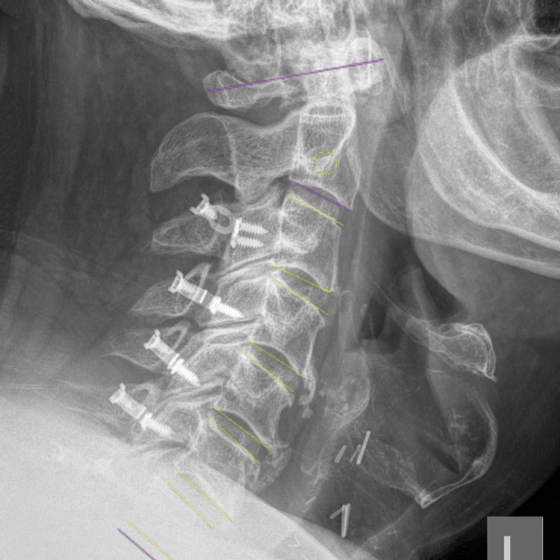Cervical Laminoplasty
Cervical Laminoplasty is a surgical procedure performed to relieve pressure on the spinal cord in the cervical spine (neck) caused by conditions such as cervical stenosis, cervical myelopathy, ossification of the posterior longitudinal ligament (OPLL), or spinal cord compression from other degenerative changes. Unlike cervical laminectomy, which involves removing parts of the vertebrae, laminoplasty preserves the vertebral structure by reshaping and expanding the spinal canal, providing relief while maintaining spinal stability. Unlike fusion, motion is preserved through the cervical spine.
Why Choose Cervical Laminoplasty?
Cervical Laminoplasty is often chosen as an alternative to laminectomy and fusion, especially in patients who need spinal decompression but wish to preserve more of their natural spinal motion and structure. This procedure is beneficial for patients with multilevel spinal cord compression and is aimed at preventing further neurological deterioration. The procedure is not suitable for everyone, especially those that have lost their normal curvature (lordosis) of the cervical spine.
What Happens During Cervical Laminoplasty Surgery?
Preparation
Hospital Admission: You will be admitted to the hospital on the day of surgery. Fasting is required before the procedure, following the instructions provided by your anaesthetist.
Anaesthesia: The procedure is performed under general anaesthesia, ensuring you are asleep and pain-free throughout the surgery.
Surgical Approach
Patient Positioning: You will be positioned face down (prone) on the operating table to allow access to the back of your neck. Your head is secured with a specialised frame which anchors your scalp using some pins.
Incision: A midline incision is made in the back of the neck, and the muscles and soft tissues are carefully moved aside to expose the vertebrae of the cervical spine.
Laminoplasty Procedure
Hinge Creation: A/Prof Buckland creates a hinge on one side of the vertebrae by carefully thinning the lamina (the part of the vertebra that covers the spinal canal) without completely removing it.
Opening the Spinal Canal: The opposite side of the lamina is cut completely, allowing the spinal canal to be expanded like opening a door. This relieves pressure on the spinal cord and nerves.
Placement of Bone Grafts or Spacers: Small bone grafts or spacers are placed at the site of the hinge to hold the newly created opening in place, preventing it from closing and ensuring the spinal cord remains decompressed.
X-ray Verification: X-rays may be taken during the procedure to confirm the proper positioning of the grafts or spacers and the expansion of the spinal canal.

Closure
The surgical site is carefully closed with sutures, and a sterile dressing is applied to protect the wound. The muscles and tissues are repositioned to minimize the risk of complications.
Postoperative Care and Recovery
Hospital Stay
Most patients stay in the hospital for 2-3 days following cervical laminoplasty, depending on the extent of the surgery and their recovery progress.
Pain Management
Pain is managed with medications, and early mobilization is encouraged to reduce the risk of complications such as blood clots or pneumonia. Some stiffness and discomfort in the neck are common in the first few days following surgery.
Rehabilitation
Physical Therapy: A rehabilitation program will begin shortly after surgery, focusing on restoring neck mobility, strength, and function. Physical therapy plays a crucial role in a successful recovery.
Activity Restrictions: You will be given a collar to wear after the surgery for the first 4-6 weeks. You will need to avoid heavy lifting, twisting, and overhead activities for around 3 months after surgery. A gradual return to normal activities will be guided by your healthcare team.
Follow-up
Regular follow-up appointments will be scheduled to monitor the healing process, assess the success of the decompression, and adjust your rehabilitation plan as needed.
Risks and Complications
As with any surgery, there are potential risks, including:
-
- Infection: There is a risk of infection at the surgical site.
- Bleeding: Excessive bleeding during or after surgery is possible.
- Nerve Injury: There is a risk of injury to the spinal nerves, which could result in weakness, numbness, or other neurological symptoms.
- Incomplete Decompression: In some cases, the decompression may not fully relieve symptoms, potentially requiring additional treatment.
- Cervical Spinal Deformity: Although uncommon, deformity of the cervical spine (neck) can develop in the months to years after surgery.
- Neck Stiffness: Some patients may experience long-term stiffness in the neck following surgery.
Long-Term Outlook
Symptom Relief: Many patients experience significant relief from symptoms such as neck pain, arm pain, and neurological deficits following cervical laminoplasty. Recovery of symptoms of chronic spinal cord damage are difficult to predict and often incomplete. The specifics should be discussed with A/Prof Buckland at your preoperative visit.
Motion Preservation: Unlike fusion, laminoplasty preserves more natural neck movement, which can be beneficial for long-term function.

